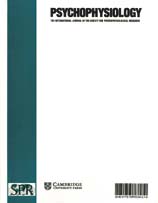Crossref Citations
This article has been cited by the following publications. This list is generated based on data provided by
Crossref.
Ettinger, Ulrich
Kumari, Veena
Crawford, Trevor J.
Davis, Robert E.
Sharma, Tonmoy
and
Corr, Philip J.
2003.
Reliability of smooth pursuit, fixation, and saccadic eye movements.
Psychophysiology,
Vol. 40,
Issue. 4,
p.
620.
Dyckman, Kara A.
and
McDowell, Jennifer E.
2005.
Behavioral plasticity of antisaccade performance following daily practice.
Experimental Brain Research,
Vol. 162,
Issue. 1,
p.
63.
Klein, Christoph
and
Feige, Bernd
2005.
An independent components analysis (ICA) approach to the study of developmental differences in the saccadic contingent negative variation.
Biological Psychology,
Vol. 70,
Issue. 2,
p.
105.
Klein, Christoph
and
Fischer, Burkhart
2005.
Instrumental and test–retest reliability of saccadic measures.
Biological Psychology,
Vol. 68,
Issue. 3,
p.
201.
Gooding, Diane C.
Shea, Heather B.
and
Matts, Christie W.
2005.
Saccadic performance in questionnaire-identified schizotypes over time.
Psychiatry Research,
Vol. 133,
Issue. 2-3,
p.
173.
Raemaekers, M.
Vink, M.
Zandbelt, B.
van Wezel, R.J.A.
Kahn, R.S.
and
Ramsey, N.F.
2007.
Test–retest reliability of fMRI activation during prosaccades and antisaccades.
NeuroImage,
Vol. 36,
Issue. 3,
p.
532.
Phillipou, Andrea
Douglas, Jacinta
Krieser, David
Ayton, Lauren
and
Abel, Larry
2014.
Changes in saccadic eye movement and memory function after mild closed head injury in children.
Developmental Medicine & Child Neurology,
Vol. 56,
Issue. 4,
p.
337.
Jamadar, Sharna D.
Johnson, Beth P.
Clough, Meaghan
Egan, Gary F.
and
Fielding, Joanne
2015.
Behavioral and Neural Plasticity of Ocular Motor Control: Changes in Performance and fMRI Activity Following Antisaccade Training.
Frontiers in Human Neuroscience,
Vol. 9,
Issue. ,
Heath, Matthew
Weiler, Jeffrey
Gregory, Michael A.
Gill, Dawn P.
Petrella, Robert J.
and
Lanctôt, Krista
2016.
A Six-Month Cognitive-Motor and Aerobic Exercise Program Improves Executive Function in Persons with an Objective Cognitive Impairment: A Pilot Investigation Using the Antisaccade Task.
Journal of Alzheimer's Disease,
Vol. 54,
Issue. 3,
p.
923.
Meyhöfer, Inga
Bertsch, Katja
Esser, Moritz
and
Ettinger, Ulrich
2016.
Variance in saccadic eye movements reflects stable traits.
Psychophysiology,
Vol. 53,
Issue. 4,
p.
566.
Rodrigue, Amanda L.
Austin, Benjamin P.
and
McDowell, Jennifer E.
2017.
Plasticity of prefrontal cortex connectivity in schizophrenia in response to antisaccade practice.
Psychiatry Research: Neuroimaging,
Vol. 265,
Issue. ,
p.
77.
Shellington, Erin M.
Heath, Matthew
Gill, Dawn P.
and
Petrella, Robert J.
2017.
Long-Term Maintenance of Executive-Related Oculomotor Improvements in Older Adults with Self-Reported Cognitive Complaints Following a 24-Week Multiple Modality Exercise Program.
Journal of Alzheimer's Disease,
Vol. 58,
Issue. 1,
p.
17.
Turner, Travis H.
Renfroe, Jenna B.
Duppstadt-Delambo, Amy
and
Hinson, Vanessa K.
2017.
Validation of a Behavioral Approach for Measuring Saccades in Parkinson's Disease.
Journal of Motor Behavior,
Vol. 49,
Issue. 6,
p.
657.
Samani, Ashna
and
Heath, Matthew
2018.
Executive-related oculomotor control is improved following a 10-min single-bout of aerobic exercise: Evidence from the antisaccade task.
Neuropsychologia,
Vol. 108,
Issue. ,
p.
73.
Heath, Matthew
Petrella, Andrea
Blazevic, Jonathan
Lim, David
Pelletier, Andre
and
Belfry, Glen R.
2018.
A post-exercise facilitation of executive function is independent of aerobically supported metabolic costs.
Neuropsychologia,
Vol. 120,
Issue. ,
p.
65.
Petrella, Andrea F.M.
Belfry, Glen
and
Heath, Matthew
2019.
Older adults elicit a single-bout post-exercise executive benefit across a continuum of aerobically supported metabolic intensities.
Brain Research,
Vol. 1712,
Issue. ,
p.
197.
Pierce, Jordan E.
Clementz, Brett A.
and
McDowell, Jennifer E.
2019.
Eye Movement Research.
p.
11.
Klein, Christoph
Seernani, Divya
Ioannou, Chara
Schulz-Zhecheva, Yoanna
Biscaldi, Monica
and
Kavšek, Michael
2019.
Eye Movement Research.
p.
635.
Tari, Benjamin
Vanhie, James J.
Belfry, Glen R.
Shoemaker, J. Kevin
and
Heath, Matthew
2020.
Increased cerebral blood flow supports a single-bout postexercise benefit to executive function: evidence from hypercapnia.
Journal of Neurophysiology,
Vol. 124,
Issue. 3,
p.
930.
Płomecka, Martyna Beata
Barańczuk-Turska, Zofia
Pfeiffer, Christian
and
Langer, Nicolas
2020.
Aging Effects and Test–Retest Reliability of Inhibitory Control for Saccadic Eye Movements.
eneuro,
Vol. 7,
Issue. 5,
p.
ENEURO.0459-19.2020.

